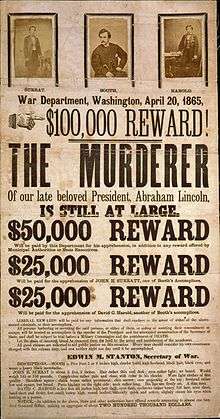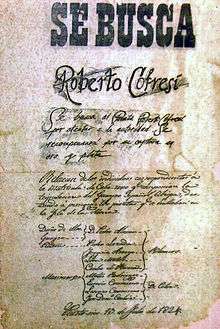Wanted poster

A wanted poster (or wanted sign) is a poster distributed to let the public know of an alleged criminal whom authorities wish to apprehend. They will generally include either a picture of the alleged criminal when a photograph is available or of a facial composite image produced by police.
Description

The poster will usually include a description of the wanted person(s) and the crime(s) for which they are sought. Wanted posters are usually produced by a police department or other public government body for display in a public place, such as on a physical bulletin board or in the lobby of a post office, but in ages past wanted posters have also been produced by vigilante groups, railway security, private agencies such as Pinkerton, or by express companies that have sustained a robbery. Wanted posters also might include rewards for providing aid in the capture of the wanted person, usually in the form of money. These types of posters were also referred to as reward posters.
Electronic billboards
In 2007, the FBI began posting wanted posters on electronic billboards starting with 23 cities, and have been working to expand this system in other states. This allows them to instantly post a wanted notice in public view across the US. In 2014, the FBI claimed that at least 53 cases had been solved as a direct result of digital billboard publicity, and many others had been solved through the Bureau’s overall publicity efforts that included the billboards. The FBI now claims to have access to over 5,200 billboards nationwide.[1]
Bounty
Wanted posters for particularly notorious fugitives frequently offer a bounty for the capture of the person, or for a person who can provide information leading to such capture. Bounties provided an incentive for citizens to aid law enforcement, either by providing information, or by catching the criminal themselves. More modern wanted posters may also include images of the fugitive's fingerprints. People who chased wanted men with intent to collect their bounties were often referred to as bounty hunters.
Images
Composite images for use in wanted posters can be created with various methods, including:
- E-FIT: Electronic Facial Identification Technique via computer
- Identikit
- PhotoFIT: Photographic Facial Identification Technique
Dead or alive
Historically, some wanted posters offering a reward contained the phrase "dead or alive". Thus one would get a reward for either bringing the person or their body to the authorities. This could indicate that the person was an outlaw, and that it was permissible to kill them. Alternatively it might mean that it was permissible to kill them if they resisted arrest.
Wanted posters in the media
Wanted posters have been used by media sources to cast prominent figures as wild west criminals. Popular examples of this include the September 4, 1939 Edition of the British newspaper the Daily Mirror, which cast Adolf Hitler as a ‘reckless criminal’ ‘wanted dead or alive’.[2] This idea was also used by The Times in their global search for Osama Bin Laden in 2001.[3]
See also
- All-points bulletin
- America's Most Wanted
- Pittura infamante
- Rewards for Justice Program
- Clarendon (typeface)
- Mug shot publishing industry
References
- ↑ "Catching Fugitives in the Information Age." FBI. FBI, 24 Dec. 2014. Web. 25 Mar. 2015.
- ↑ "Wanted Poster for Hitler." Wanted Poster for Hitler. The British Library
- ↑ "Wanted By The FBI." FBI. FBI, 20 July 2010.
| Wikimedia Commons has media related to Wanted posters. |